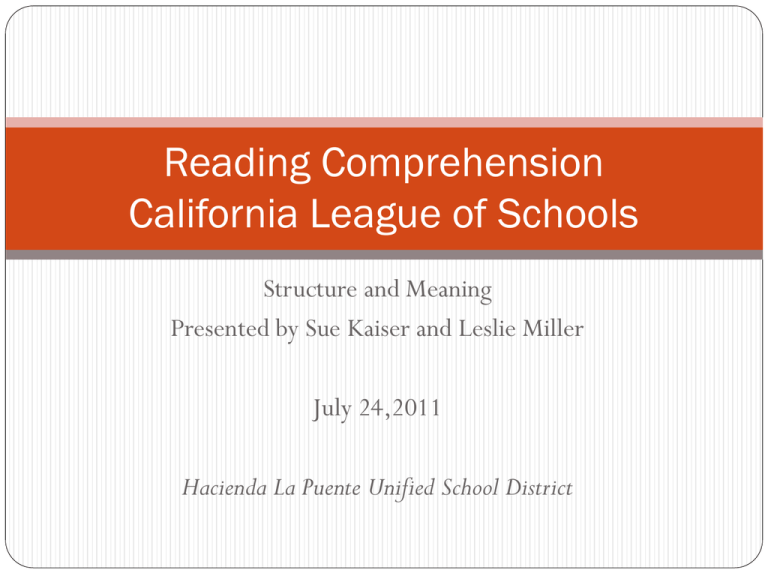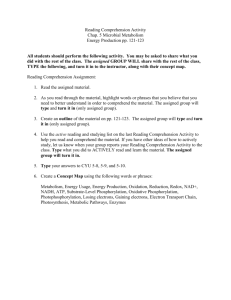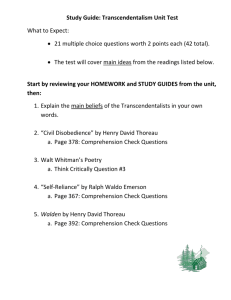Hacienda La Puente Unified School District
advertisement

Reading Comprehension California League of Schools Structure and Meaning Presented by Sue Kaiser and Leslie Miller July 24,2011 Hacienda La Puente Unified School District How did you learn to comprehend? • We were taught to comprehend largely by teachers asking us questions about the text or by answering questions that were in the printed text. • Old saying – “we parent the way we were parented” - guess what? We teach the way that we were taught! • In strategy driven comprehension, we teach children to pose the questions. This develops meta-cognitive thinking, independence and critical thinking skills. Let’s test it with reading comprehension strategies: – Question – the students may ask, “I wonder why the witch is green in the Wizard of Oz?” or “hmmm, why did Goldilocks feel so comfortable entering the 3 little bears house?” – Monitor – the students may ask, “Whoa! I am a little confused about what is happening now in the text, do I need to reread, or read ahead to understand what is happening?” – How might a student develop questions with another strategy? Teach the strategy, not the story! • In strategic reading comprehension teaching, we begin each lesson • • • • with a careful analysis of the standards. We then consider the story on the pacing guide, looking to see what skills and strategies are to be taught during this portion of time in the year. We develop a “kid friendly” example to help students understand the strategy We end each lesson with a written question designed like a CST question to further students’ knowledge of the tested language and frame. Focused comprehension lessons must target the thinking as it occurs during reading. Teachers must talk about the thinking processes involved during reading. Houghton Mifflin • The Houghton Mifflin curriculum contains 6 strategies and several • • • • skills The strategies are all student questioning techniques which are meta-cognitive in nature. The skills are the tools for comprehension – many can be represented graphically Each selection has one strategy and one skill focus for the entire selection. H.M. suggests that you teach comprehension 90 – 110 minutes a day – realizing that you probably don’t have time for that….45 minutes to an hour in a direct/explicit lesson is what is expected. Structure of Reading Comprehension • In the article “Why Kids Don’t Like School” the author argues that humans are mammals. • Mammals thrive on routines and procedures • When teachers ask students to think on their own – they don’t like it because it is not natural for mammals to do. • Therefore, we must develop procedures and routine for the thinking that we want students to do Reading Comprehension is Thinking We are going to explore the framing of reading comprehension – skills and strategies. These are the procedures and routines. We will be sharing lesson frames that will allow us to better teach students to comprehend and that will allow us to more easily teach the thinking that is involved and overwhelming for our students. What does the research say? The current researchers and developers of language arts curriculum and instruction agree on the following concepts: Comprehension strategies must be taught explicitly and directly Children need to read in and out of a wide variety of text Children must couple reading and oral responses as they hone their reading comprehension skill Comprehension Text Structure 6 Strategies Skills Expository or Narrative Evaluate Monitor/clarify Phonics/decoding Question Summarize Predict/Infer Fantasy, realism, cause and effect, categorize/classify, problem solving, compare/contrast, predicting outcomes, noting details, drawing conclusions, making generalizations, making inferences, story structure, characters, setting, plot, author’s viewpoint, making judgments, sequence of events, fact and opinion Major Comprehension Strategies Preparational Strategies • Previewing • Setting purpose and goals • Predicting Activating Prior Knowledge Organizational Strategies • Comprehending the main idea • Organizing details • Following directions Determining important details Sequencing Summarizing Making inferences Elaboration Strategies • Imagining • Generating questions • Evaluation Metacognitive Stategies • Regulating • Checking • Repairing Hoatzin • A hoatzin has a clever way of escaping from its • • • • enemies. It generally builds its home in a branch that extends over a swamp or stream. If an enemy approaches, the hoatzin plunges into the water below. Once the coast is clear, it uses its fingerlike claws to climb back up the tree. Hoatzin are born with claws on their wings but lose the claws as they get older. Bridge What role did previous knowledge play in your understanding of the hoatzin? What we know old What we do not know new What researchers say about the bridge R.C. Anderson, who contributed to the document Becoming a Nation of Readers states: Our knowledge is packaged into schema Comprehension involves activating or constructing a schema that helps us make sense of the elements of the text Background Knowledge Students’ experiences provide one type of background knowledge – specific experiential knowledge. Additional types of background knowledge that may help students understand text: Relationship knowledge Knowledge of the world Knowledge of themselves – their own reactions and emotions As you read Hoatzin, what did you activate? What did you construct? Activating Constructing Hoatzin What was your first prediction? What did a mental summary of the first 3 sentences reveal? How did your inference skills help you when you read about the wings? Lesson Frame Begin with the standard/objective Strategy/skill Thinking map/Graphic organizer Kid-friendly example Apply the strategy/skill to the story or reading piece Use the gradual release model Close with a CST look alike as you do the final checking for understanding Now, Let’s go an a little field trip! http://cis.lacoe.edu/reading Instructional resources Comprehension strategy lesson To see Amada La Fleur from Kwis Elementary School teach a reading comprehension lesson Reading Comprehension Lesson #2: Drawing Conclusions http://www.lacoe.edu/admin/forms/FLVPlayerWindow.cfm? Server=rtmp://flashmedia.lacoe.edu/vod&Stream=Amand a_all






